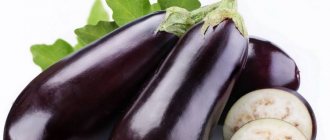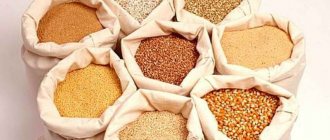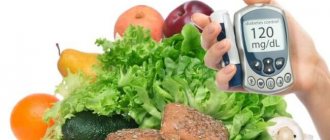Type 2 diabetes mellitus imposes certain restrictions on the patient’s lifestyle. This is especially true for nutrition - you should eat small, varied and balanced, healthy foods, giving preference to fruits, vegetables and whole grains, lean meat, fish and dairy products. Endocrinologists have also developed a special diet that divides all foods into recommended, acceptable and undesirable. Let's take a closer look at each category in our article.
Tips for reducing sugar levels
Reducing sugar levels in diabetes mellitus can be achieved through a combination of physical activity, medication and a balanced diet. This balance will help:
- Maintain blood glucose, blood pressure, and cholesterol levels within target ranges;
- lose weight or stay at a healthy weight;
- prevent the development of complications;
- maintain good health and energy 1.
There are general rules for creating a diet to control sugar content:
- Plate rule. Take a plate with a diameter of 23 cm and mentally divide it into 4 equal parts. Half of it should be vegetables (except potatoes, peas and corn), a quarter should be lean proteins, and a quarter should be grains or other starchy foods1
- Minimizing sweetened products: sugary drinks are especially dangerous - lemonade, tea with sugar, industrial fruit juices2
- It is better to use fresh fruits and vegetables as snacks.
- Steam, stew, bake food in its own juice, without adding oil, as it increases the total calorie content3
Table No. 9
Diet No. 9, specially developed for diabetics, is widely used in inpatient treatment of such patients and should be followed at home. It was developed by the Soviet scientist M. Pevzner.
The diet for diabetics includes daily intake of up to:
- 500 ml of fermented milk products, 200 g of low-fat cottage cheese;
- 100 gr. mushrooms;
- 300 gr. fish or meat;
- 80 gr. vegetables;
- 300 gr. fruit;
- 1 glass of natural fruit juice;
- 100-200 gr. rye, wheat mixed with rye flour, bran bread or 200 grams of potatoes, cereals (ready-made);
- 40-60 gr. fat
Main dishes:
- Meat, poultry: veal, rabbit, turkey, chicken, boiled, chopped, stewed.
- Soups: cabbage soup, vegetable soup, borscht, beetroot soup, meat and vegetable okroshka, light meat or fish broth, mushroom broth with vegetables and cereals.
- Appetizers: vinaigrette, mixed fresh vegetables, vegetable caviar, salt-soaked herring, jellied dietary meat and fish, seafood salad with butter, unsalted cheese.
- Fish: low-fat seafood and fish (pike perch, pike, cod, navaga) boiled, steamed, stewed, baked in its own juice.
- Drinks: coffee, weak tea, still mineral water, vegetable and fruit juice, rose hip decoction (without sugar).
- Sweets: desserts made from fresh fruits, berries, fruit jelly without sugar, berry mousses, marmalade and jam without sugar.
- Egg dishes: white omelet, soft-boiled eggs, in dishes.
The difference between diets for type 1 and type 2 diabetes
In type I diabetes, the diet may have the usual calorie content typical for people of similar height and weight. The diet is supportive in nature and is clearly related to how much insulin a person living with diabetes consumes.
Type II diabetes is often accompanied by increased body weight, arterial hypertension, hypercholesterolemia and metabolic syndrome. Therefore, the diet is aimed primarily at reducing body weight. This is manifested in reduced caloric content of food, a decrease in the amount of fat and easily digestible carbohydrates in the diet.
But there are also common points: both groups of people require a complete, balanced diet of proteins, fats and carbohydrates, as well as vitamins, liquids and minerals 2.3.
Active lifestyle at home
It is useful to vacuum the house and wash the floors, and clean more often. If you need to start at an easier pace, you can try standing during TV commercials. If you can handle it, try standing for the entire commercial break and then walking in place during the commercial. You can gradually add one type of exercise at a time.
Even a small change in your daily routine (like going for a walk) will increase your activity and help you feel better about living with diabetes. Can:
- get off the bus one stop earlier;
- ride a bike;
- walk.
If you have diabetes, it is very important to stay active at work, especially if you have to sit in front of a computer for long periods of time. Useful:
- climbing stairs;
- walking meetings;
- standing while a person is talking on the phone;
- Chair exercises such as bending and raising your arms.
How to reduce the risk of complications with type 1 diabetes
Rules to follow when creating menus 2.3:
- People can consume proteins and fats without restrictions (provided they have normal body weight and take into account calorie content). If you are overweight, it is recommended to limit the fat content in your diet.
- Most vegetables can be eaten with virtually no restrictions. Without counting your sugar levels, you can eat green leafy vegetables, zucchini, peppers, cabbage, and legumes, provided they are consumed in moderation (about 200 g per meal).
- Carbohydrates, which are found in grains (bread), fruits, some vegetables (potatoes, corn), milk and dairy products, and sugar, need to be taken into account. The system of bread units helps you count carbohydrates.
Bread unit system
One bread unit is the amount of any product that contains from 10 to 12 grams of carbohydrates. This is exactly how much is contained in one piece of bread, which is why the units are called bread units (XE). You can find out their content in a particular product from special tables 2.
The bread unit system helps determine the dose of short-acting insulin, which is administered before meals. To do this, you need to measure your glucose level and count how many units the portion you plan to eat contains. According to recommendations, one serving should contain no more than 8 XE. Based on these data, the required dose of insulin 2.4 is calculated.
Diabetes mellitus type 2: nutrition principles
The diet for type 2 diabetes mellitus depends on body weight: with normal weight, the number of calories should correspond to expenses, with increased weight, it should be lower than them (low-calorie diet, hypocalorie diet).
Basic principles of nutrition for type 2 diabetes 3-6:
- Food should be rich in fiber, which inhibits the absorption of sugar, preventing a sharp increase in blood glucose levels. This is achieved due to the high content of vegetables in the diet. On average, the level of fiber in the daily menu should be from 20 to 40 grams.
- When preparing food, it is better to keep cooking to a minimum. It is important to remember that when grinding or heat processing carbohydrate-containing products, glucose is absorbed much faster.
- Sugar and products containing it, including tea and coffee with sugar, should be limited as much as possible.
- Sweeteners can be eaten in moderation, taking into account calorie content. Non-caloric sweeteners saccharin and aspartame can be consumed as needed. The so-called sugar analogues xylitol, sorbitol, and fructose are rich in calories, so they are not recommended for overweight.
- Alcohol is harmful to health, including diabetes. It is high in calories—1 gram of pure alcohol contains 7 kcal—and may contribute to weight gain and poor diabetes control.
Sweeteners
Regardless of the type of diabetes, sugar in its pure form is prohibited. For diabetic patients, the use of sweeteners in limited quantities is allowed. The most common are:
- trichlorogalactosucrose or sucralose;
- food additives: E950 (acesulfame potassium), 951 (aspartame), 952 (sodium cyclamate).
- stevioside (glycoside from the leaves of the stevia plant).
Some of the sweeteners have a number of contraindications and therefore require prior medical consultation.
Consumption of sugar substitutes does not affect glycemic levels
Nutritional Guidelines to Reduce the Risk of Complications in Type 2 Diabetes
To reduce the risk of developing cardiovascular complications, as well as normalize lipid metabolism, it is important to follow several more principles of a healthy diet 2-6:
- Reduce saturated fat: it should not account for more than 10% of your total daily calories. Red meat, dairy products, baked goods, fast food, egg yolks, and sausages are rich in saturated fats.
- Unsaturated fats should be consumed in required quantities. They are found in vegetable oils, fish, nuts, and seeds. About 2/3 of the total amount of fat should be of vegetable origin - olive and other vegetable oil.
- The salt content must be reduced to 5 grams per day, and in the presence of edema - to 3 grams.
Diet of an insulin-dependent patient
Before preparing your own diet, you should consult a specialist. It is better to show the finished menu option to your doctor. It is optimal to develop a menu for the week so as not to experience daily difficulties with choosing products.
Approximate digital norms of daily diet (in grams):
- cereal dishes – 50–60;
- potatoes – 60–70;
- whole grain bread – 150–2170;
- legumes and vegetables – up to 700;
- fermented milk drinks / cottage cheese / sour cream – 250 / 150 /10–15;
- protein (meat, fish) – up to 150;
- fruits and berries – 200.
Important! The figures are averaged. Specific values must be selected individually, taking into account the characteristics of the course of diabetes.
Possible options
In the developed sample menu, dishes can be swapped. Fruit and vegetable ingredients in the diet are also allowed to be replaced with analogues that are identical in GI and calorie content. For quick and high-quality cooking, it is best to purchase a multicooker.
Examples of dishes for diabetic patients
| Breakfast | Soup | Garnish | Basics | Lunch/afternoon snack |
| milk oatmeal with fruit; omelette with herbs; toast with Adyghe cheese + boiled eggs; wheat (barley) porridge in water with the addition of sour cream or butter; cottage cheese casserole cooked in a slow cooker | cabbage soup in chicken broth; mushroom soup; bean (pea) soup based on turkey or chicken; broth with veal (chicken) meatballs; fish soup from different varieties of fish; seafood soup with vegetables | lobio; Boiled potatoes; crumbly buckwheat or pearl barley porridge; vegetable puree or steamed vegetables; durum wheat pasta (durum) | boiled meat (veal, turkey, chicken); chicken breast baked in foil with tomatoes; vegetable stew with turkey; stewed cabbage with chicken (rabbit); stuffed peppers (stuffed cabbage rolls); fish baked with vegetables; cutlets (bits) from meat or fish | diabetic cheesecakes; pureed cottage cheese with fruit; yogurt; waffles or gingerbread for diabetics; fruit and berry jelly or puree; 100 g specially prepared baked goods |
About salads for diabetics
Vegetable salads (Greek, cucumbers + tomatoes, cabbage) must be present in your daily diet. Other recipes for type 1 diabetics:
- ¼ small head of cabbage + 1 raw beets + 2 raw carrots. Finely chop the cabbage, grate the carrots and beets. For dressing, use a mixture of lemon juice and olive oil. Spices - to taste.
- 150 g crab meat, 1 fresh cucumber, 1 onion, a bunch of dill, a can of canned seaweed. Cut the crab meat, cucumber and onion into cubes, add herbs and kelp. Season with natural yoghurt (sour cream) and a teaspoon of soy sauce.
A useful vegetable addition to the menu of diabetics is sauerkraut. To prepare a delicious salad, it is recommended to add chopped onions, fresh dill, and a little cranberries. Season with unrefined sunflower oil.
To taste, you can diversify the dish with grated apple
Multicooker dishes
There are a lot of diabetic recipes for slow cooker dishes. The device is easy to use and allows you to prepare food efficiently and quickly. Examples:
- Several parallel cuts are made in the chicken breast. The meat should be marinated in a mixture of garlic, soy sauce, pepper and vegetable oil for 1–2 hours. Insert tomato mugs and slices of Adyghe cheese into the cuts. Wrap the resulting workpiece tightly in several layers of foil. Set the device to the “baking/pork” mode for 60 minutes.
- Cut the fish into portions, salt and pepper, sprinkle with olive oil and lemon juice. Place a tomato slice on top. Wrap each piece in foil. Bake in the same way.
- Pour 20 g of hot-pressed olive oil into a multicooker, add chopped onion, 150 g of boiled mushrooms, one grated carrot. Take 200 g of buckwheat, rinse, pour into the device. Add bay leaf and peppercorns. Pour 500 ml of water. Mix. Cook on the “rice/porridge” mode for 40 minutes.
Diabetic cake
To prepare delicious baked goods you will need the following products:
- one glass of rye flour;
- one chicken or 3-4 quail eggs;
- fructose – 0.5 tsp;
- olive oil – 2 tbsp. l.
Mix the ingredients, knead the dough and let it rest for 30-40 minutes in the refrigerator. The cream for the cake is prepared from 250 g of cottage cheese (9%), 250 g of sour cream (10%), 20 g of gelatin, 60 g of fructose. Soak the gelatin in 50 ml of water at room temperature and let it swell (20 minutes). Beat cottage cheese, sour cream and fructose with a mixer. Carefully pour in the gelatin and stir. Add fruits and berries to the cream to taste.
Advice. It is recommended to mix products with a silicone spatula. This will keep the mass airy.
Distribute the dough into a pre-greased pan and bake until done. Cool, place cottage cheese and fruit cream on top. Place in the refrigerator for 2-3 hours. If desired, fruits can not be mixed into the cream, but simply placed on the finished product. Without following a diet, a patient with type 1 diabetes will be forced to use large doses of insulin. Incorrect treatment will lead to rapid depletion of the body's resources and to the premature development of severe complications of diabetes.
Nutrition rules for every day
- Eat more dietary fiber. There is evidence of a reduction in mortality in people with diabetes when fiber is added to their diet (at least 14 g per 1000 g of food eaten).
- Limit the content of trans fats as much as possible: on product labels they are designated as “hydrogenated vegetable fats”, “margarine”, “milk fat substitute”, etc. 8
- Reduce the amount of sugars, refined grains and high-starchy foods.
- Replace sugar with sweeteners.
- Give preference to whole foods. 9
What you need to know about the glycemic index?
The glycemic index (GI) can be low (up to 55), medium (56-69) and high (from 70 to 100).
The same product may have a different GI depending on the method of preparation. For example, for mashed potatoes this indicator is 85-95, which is a very high value. For fried potatoes, the GI drops to 60-75, and for boiled potatoes that have been left in the refrigerator, the GI is 50. The difference is quite significant. Cooked pasta, cereals or cereals have a higher GI than whole grain cereals or pasta eaten semi-solid.
To reduce the GI, freshly prepared food can be refrigerated and then reheated. Adding bran to a dish also helps reduce the glycemic index.










